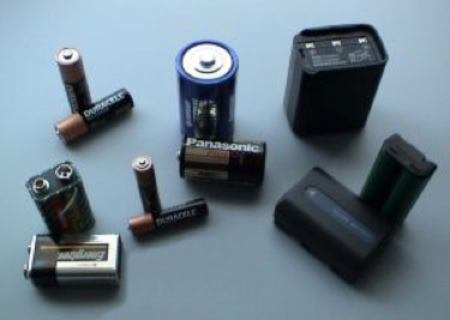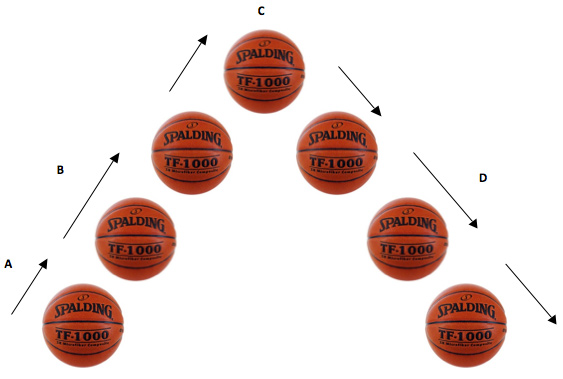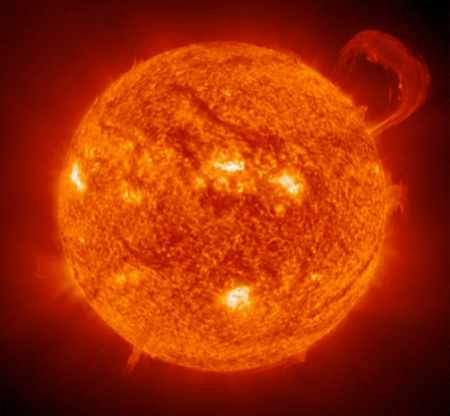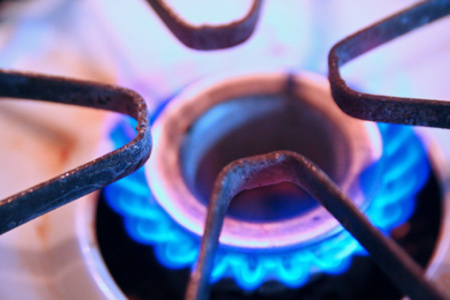
Source: Batteries, Braniac, Wikimedia commons

At which point does the bouncing basketball (above) have the highest potential energy?
A.
Incorrect. The ball is not at its highest point.
B.
Incorrect. The ball is moving (kinetic energy) and is not at its highest point.
C.
Correct! Potential energy is due to position and point C is the highest point that the basketball reaches.
D.
Incorrect. The ball is moving (kinetic energy) and is not at its highest point.
Skateboarding on a ramp is an example of a continual exchange between —
A. chemical and physical properties
Incorrect. Skateboarding on a ramp does not deal with an exchange between chemical and physical properties.
B. potential and kinetic energy
Correct ! As the skateboarder reaches and stops at the top of the ramp, their potential energy increases. As they go down the ramp, there is a conversion to kinetic energy – energy of motion.
C. energy and its mass
Incorrect. Energy does not have a mass.
D. radiant and chemical energy
Incorrect. Radiant energy deals with energy from waves and chemical energy comes from the energy in chemical bonds.
A gas-powered car travels from point A to point B. What forms of energy below must occur for this to happen?
A. Chemical energy and mechanical energy
Correct! The fuel in the car is chemical potential energy and the movement of the car is mechanical energy.
B. Thermal energy and chemical energy
Incorrect. Thermal energy is energy of heat (movement of particles) The fuel in the car is chemical potential energy and the movement of the car is mechanical energy.
C. Radiant energy and mechanical
Incorrect. Radiant energy is energy that travels in waves. The fuel in the car is chemical potential energy and the movement of the car is mechanical energy.
D. Electrical energy and chemical energy
Incorrect. Electrical energy is energy due to the movement of electrons. The fuel in the car is chemical potential energy and the movement of the car is mechanical energy.
Glucose, the food which plants produce through photosynthesis, can best be described as which of the following —
A. kinetic chemical energy
Incorrect. Chemical energy, the energy stored in chemical bonds, is potential energy, not kinetic energy.
B. potential nuclear energy
Incorrect. Nuclear energy is the energy created by fission or fusion within an atom. This is not a process that occurs in a plant during photosynthesis.
C. potential chemical energy
Correct! Food is considered to be potential chemical energy. The energy is stored in the chemical bonds of the glucose.
D. kinetic nuclear energy
Incorrect. Nuclear energy is the energy created by fission or fusion within an atom. This is not a process that occurs in a plant during photosynthesis. Also, nuclear energy is potential energy, not kinetic energy.
Which list of energy forms correctly and sequentially identifies the pictures below?
Battery

Source: Batteries, Braniac, Wikimedia commons
Wind Turbine

Source: Windmills, Openphoto.net
The Sun

Source: Red Hot Sun, Mrshaba, Wikimedia Commons
Stove Burner

Source: Burner, Stevendepolo, Flickr
A. Chemical, mechanical, radiant, thermal
Correct! A battery has chemical potential energy, A wind turbine turning is mechanical energy, and the sun gives us radiant energy, the burner on the stove illustrates thermal energy.
B. Mechanical, nuclear, thermal, chemical
Incorrect. A battery has chemical potential energy, A wind turbine turning is mechanical energy, and the sun gives us radiant energy, the burner on the stove illustrates thermal energy.
C. Electrical, mechanical, chemical, thermal
Incorrect. A battery has chemical potential energy, A wind turbine turning is mechanical energy, and the sun gives us radiant energy, the burner on the stove illustrates thermal energy.
D. Mechanical, electrical, chemical, radiant
Incorrect. A battery has chemical potential energy, A wind turbine turning is mechanical energy, and the sun gives us radiant energy, the burner on the stove illustrates thermal energy.